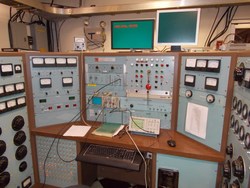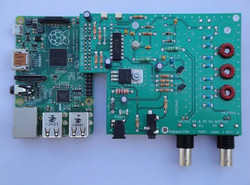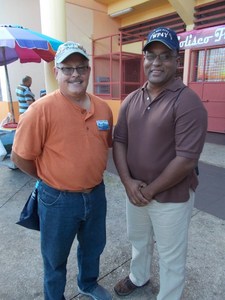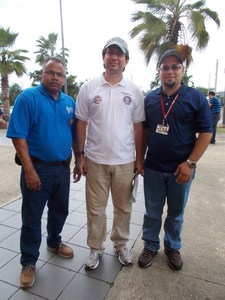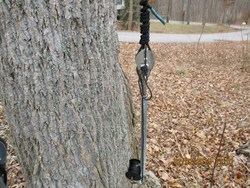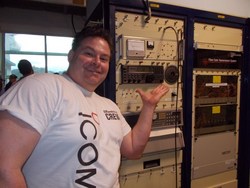 February 11, 2015 Editor: Ward Silver, NØAX | |||||||||
IN THIS ISSUE
NEW HF OPERATORS - THINGS TO DO The joys of working CW DX are rarely more available to HF newcomers in the US and Canada than in the ARRL's International DX CW Contest. You don't have to fight through layers of DX stations - the DX is calling you! And the CQ WW RTTY WPX contest is a great way to get your fingers wet on the digital modes, too. BULLETINS There are no bulletins in this issue. BUSTED QSOS Here is the correct link for N4ZR's front-end protector article. Some spurious characters were added to the link in the previous issue. (Thanks, Larry W6NWS) And the correct link to the ARRL Contest Results page is www.arrl.org/contest-results-articles (Thanks, Mike VE3GFN) CONTEST SUMMARY Complete information for all contests follows the Conversation section February 14-15
February 21-22
CQ World Wide has added a Cabrillo Opt-Out tag for certificates. After the CERTIFICATE: tag, simply add YES (the default) or NO. Since one of the biggest expenses of running a contest is the printing and mailing of paper certificates, this will help the contest make better use of available resources. Not all sponsors support this tag as yet. Downloadable electronic format certificates are not expected to be affected by this tag. (Thanks, Randy K5ZD, CQ Worldwide Contest Director)
IEEE members should take a look at the February 2015 issue of IEEE Microwave Magazine for the article "RF and Microwave Links: The MTT Society and the Amateur Radio Community". Authored primarily by IEEE Fellow Robert Caverly WB4PWZ, he was joined by your editor, Al Katz K2UYH, Rick Campbell KK7B, and Marc Franco, N2UO/LU6DW. The Microwave Theory and Techniques (MTT) Society's MTT-17 committee was very helpful in promoting and contributing to this article. Top Gun among RTTY ops, Ed WØYK was recognized both for his contesting and vineyard achievements in this story by the San Jose Mercury News. The well-written article captures the general sense of contesting quite well, especially the convergence between vineyard and ham station siting. While the article notes the need for younger hams, it is balanced with a mention of new technology available and being used by hams. (Thanks, Bob N6TV)
Point-and-click could become point-and-log with this new smart ring that allows you to write messages just by waving your finger around! A new release of the Super Check Partial database files is available from Stu K6TU. The number of calls in the file has grown to 45,949! You can send your log to Stu when you submit it to the contest sponsor. Dave G4BUO writes with the news that he is cancelling the EU Sprint contests. "It was a great idea of Paolo's (I2UIY - SK), but even while he was alive we struggled to get anything like the level of interest from European operators (enjoyed) in the NA events." Perhaps someone or some group will step up to re-animate this contest - if so, you'll read about it here in the Contest Update. Web Site of the Week - How did all this "electrical engineering" stuff get started? Some claim it was Tesla's multi-phase ac machines, others the telephone system, but there is a good story in a fried undersea cable and the race to understand and fix the problem. WORD TO THE WISE As log checking reports start appearing from the fall contests, the term Unique+1 sometimes comes up. A unique+1 is a call that is (a) "one off" from a unique call and (b) is a call of someone who was active in the contest. If you claimed contact with N9RU, and no one else in the contest worked N9RU, it is a unique. If N9RV was active in the contest, that is a unique+1. N9RD could also be considered a U+1 if active. (From the Contest University Glossary by Pat N9RV) I know we've all watched the nightly news weather report and thought, "How about a weather report for the ionosphere?" Thanks to Dr. Tamitha Mulligan Skov and Spaceweather TV, our wishes have been granted! (Thanks, Tim K3LR) Two fine training courses have been made available by Tech Online. A 40-minute video on the "Fundamentals of Circuit Protection" is available from Arrow Electronics and Littlefuse. The PDF course "Introduction to RF Design" from Rohde & Schwarz is available for downloading, as well.
This YouTube video by Mike WB6DJI shows how a noise-canceling system can make a big improvement when properly configured and used. He uses the NCC-1 Noise Canceling Controller with a TS-990S transceiver. The main antenna is a Hex Beam and the noise sensing antenna is a short piece of wire. The waterfall display adds a strong visual element to the presentation. He uses the system to knock down power-line noise and RFI from a nearby plasma TV. Climbing a woodpecker? In a way. This 20-minute video captures the view as the climber summits the famous Chernobyl antenna of the Over-The-Horizon "woodpecker" radar. (Thanks, Kirk K4RO) Dave WA8AXF reports a smartphone discovery on his Samsung Galaxy. "The settings menu slows the user to customize the vibration pattern for the ring tone when the phone is set to vibrate. You customize the pattern by tapping on the screen and immediately I thought, "Morse code!" and my vibrate ring tone is now "CQ CQ CQ"!" From the ARRL Contest Branch comes news of awards flying out the door! Envelopes with the 2014 January VHF Contest certificates and 2013 EME Contest certificates along with boxes containing the Club Gavels through the 2014 August UHF Contest have all left the building. ARRL DX Participation pins for 2015 are also available again this year.
The ARRL DX Contests are upon us and there are plaques available for sponsoring - check out the lists for the ARRL DX CW and ARRL DX Phone competitions. If you are interested, drop an email to Contest Branch Manager, Matt Wilhelm W1MSW. Chris N6WM, chairman of the California QSO Party, announces the posting of results for the 2014 contest. Many new records were set with participation at near-record levels. Special thanks are extended to John K6MM and Tom NS6T for a fantastic results page and to the entire NCCC/CQP scoring team for their hard work producing results behind the scenes! The next running of CQP will be a special 50th anniversary edition! The list of logs received for the 2014 RAC Canada Winter Contest has now been posted. (Thanks, RAC Canada Winter Contest Chairman, Sam VE5SF) OPERATING TIP The ARRL's Contest Advisory Committee has been asked to evaluate HF mobile operation in ARRL HF Contests. Specifically, should ARRL's Contest Program add a category(ies) for mobile operations and, if yes, which ARRL HF contest(s) would be the most appropriate for a mobile category? Contact your CAC rep and weigh in!
Kirk K4RO has learned some rope tricks when it comes to keeping his 40 meter wire Yagi in the air. "Several years ago I started using the rope anchoring method pictured in these photos. There is a continuous loop to a pulley at the top of each tree. The antenna rope is attached to the loop via a third pulley, which provides even more flexibility. The springs are strong enough to hold the antenna in shape, but have enough stretch to survive wind storms. The ropes ride effortlessly along the pulleys. No repairs have been necessary since using this system. The expense was well worth it to me, as it's has eliminated many hours of frustrating repair work every season." Why is it always the one-of-a-kind mechanical component which breaks? Plastic gears can be quite a problem to repair but this Instructables project shows how to replace the missing section with a little epoxy and the mating gear. As long as you're on the site, check out how to salvage electronic components from a CFL light bulb! An effective mobile station can't afford to waste a single volt of battery power so as this EDN Magazine blog entry points out, don't neglect the humble battery connector! Also on the EDN website, this article mulls the effects of laundry detergent and cat litter on the propagation of WiFi signals. If you want some serious reading on the Beverage low-band receiving antenna, there is a great list of references at the bottom of the antenna's Wikipedia page. This reference has also provided a number of measurements. (Thanks, David K1TTT)
Manfred XQ6FOD takes some of the bright edge off the LED replacements for his pilot lights with a little sandpaper. "I sand (the LED lenses) using coarse sandpaper, creating a surface that scatters the light broadly in the desired direction. If I want omnidirectional radiation, I sand the LED body into a conical shape. If I want the light mostly coming out one side of the LED, I sand a flat 45-degree surface onto it. Leaving the surface very rough...helps in obtaining excellent light distribution. Super low-power sensors are now available which can glean their power from ambient RF energy. No word about whether they can handle be supplied by the near field of a big multi-multi station! Myron WVØH found a concentrated tutorial on impedance matching showing that you can reduce your antenna system to an impedance which can then be matched using basic design tools. Self-repairing, reconfigurable electronic circuits take a step closer to reality as described in this Gizmag article. But what will we do on our workbenches? (Thanks, Dennis N6KI) Technical Web Site of the Week - If you want to make precise and accurate measurements of resistance, inductance, and capacitance, you'll want to read this Impedance Measurement Handbook from Agilent. (Thanks, Clemens DL4RAJ) Spring Is On the Air I am sure I just lost my New England readership with that title! Les N1LF posted an evocative musing on how being a VHF+ operator is a lot like being a baseball fan called "The Boys of Summer." That got me thinking and today I notice that the 2015 ARRL Field Day packet is available for downloading - could the coming of the new season be any clearer? I can still hear the muttering of W1s shoveling another load of picturesque out of the driveway.
Well, anyway, pitchers and catchers are packing and heading south to Arizona, Florida, Texas - wherever the crack of the bat and the smack of brand-new horsehide into a newly-oiled mitt resounds. We are already seeing longer daytime openings on the high bands as we move farther from the winter solstice. Along with baseball on the MF bands, come the first inklings of summertime VHF operating fun. Every day, I can turn on the radio and listen to our old orb spinning under the warming glow of our not-too-distant Sun. Bands open, bands close, and I chase the DX across them like the proverbial pot of gold at rainbow's end. Sometimes, I catch it! And while I'm busy every day, I also notice the slower shifts with the seasons. Twenty meters starts to edge a little closer to those nighttime over-the-pole openings. The southern hemisphere low-banders come in stronger and hear us better as the noise levels and absorption balance out. Not to be left out, the VHF bands join the fun on 6 meters. From not so cold and snowy Alabama, Les relates, "For me, [the coming spring] means the confident voice of August, K5HCT. Nothing heralds the arrival of the season like those first faint signals and the familiar refrain..."Here Comes Texas!" (His) is nearly always the first call I hear in the season and the last remaining on the band at its end."
Back in Washington state, the violet-green swallows would always return around my birthday and so it is on the radio. Regardless of where the sunspot count may be - up, down, or sideways - those of us who have been through a cycle or two can almost smell propagation changing at this time of year. True, on the radio leaves don't fall and the geese don't cruise overhead in honking vees, but we experience a unique changing of the seasons unknown to non-hams. Take a little time this week: Before jumping right in to those DXpedition pileups or cranking out a contest exchange, look over your log and savor what the signals sound like - feel like - as if raising your finger to the winds and looking at the clouds to sense a coming change. Spring is, indeed, on the air. 11 February through 24 February An expanded, downloadable version of QST's Contest Corral in PDF format is available. Check the sponsor's Web site for information on operating time restrictions and other instructions. HF CONTESTS ARRL Int'l CW DX Contest--CW, from Feb 21, 0000Z to Feb 22, 2359Z. Bands (MHz): 1.8-28. Exchange: RST, state/province or power. Logs due: Mar 24. Rules NAQCC Monthly QRP Sprint--CW, from Feb 11, 0130Z to Feb 11, 0330Z. Bands (MHz): 3.5-14. Monthly on 2nd Tuesday or 3rd Wednesday local time (alternating). Exchange: RST, S/P/C, and NAQCC mbr nr or power. Logs due: 4 days. Rules PODXS 070 Club Valentine Sprint--Digital, from Feb 14, 8 PM to Feb 15, 2 AM. Bands (MHz): 1.8-7. 1.807,3.580,7.070/7.035 EU/7.028 JA (MHz). Exchange: Name, OM or YL, S/P/C. Logs due: Feb 28. Rules CQ WW RTTY WPX--Digital, from Feb 14, 0000Z to Feb 15, 2400Z. Bands (MHz): 3.5-28. Exchange: RST and serial. Logs due: 5 days. Rules Asia-Pacific Sprint--CW, from Feb 14, 1100Z to Feb 14, 1300Z. Bands (MHz): 7,14. Exchange: RST and serial. Logs due: 7 days. Rules Dutch PACC Contest--Phone,CW, from Feb 14, 1200Z to Feb 15, 1200Z. Bands (MHz): 1.8-28. Exchange: RS(T) and Dutch province or serial. Logs due: Mar 15. Rules OMISS QSO Party--Phone, from Feb 14, 1500Z to Feb 15, 1500Z. Bands (MHz): 3.5-28. Exchange: RS, S/P/C and OMISS nr or "DX". Logs due: Mar 30. Rules New Hampshire QSO Party--Phone,CW,Digital, from Feb 14, 1600Z to Feb 15, 0400Z. Bands (MHz): 1.8-28. CW - 1.815 and band edge + 45kHz; Phone - 1.875, 3.935, 3.950, 7.235, 14.280, 21.380, 28.390 MHz. Exchange: RS(T) and NH county or S/P or "DX". Logs due: Mar 31. Rules FISTS CW Winter Sprint--CW, from Feb 14, 1700Z to Feb 14, 2100Z. Bands (MHz): 3.5-28. Exchange: RST, S/P/C, first name, FISTS nr or power. Logs due: 30 days. Rules RSGB - First 1.8 MHz Contest--Phone,CW, from Feb 14, 2100Z to Feb 15, 0100Z. Bands (MHz): 1.8. Exchange: RST, serial, UK district. Logs due: 16 days. Rules Run For the Bacon--CW, from Feb 16, 0200Z to Feb 16, 0400Z. Bands (MHz): 1.8-28. Monthly on 3rd Sunday night (local). Exchange: RST, S/P/C, Flying Pig nr or power. Rules Semi-Automatic Key Evening--CW, from Feb 18, 1900Z to Feb 18, 2030Z. Bands (MHz): 3.5. Exchange: RST, serial, first year of bug use. Logs due: Mar 15. Rules Russian WW PSK Contest--Digital, from Feb 20, 2100Z to Feb 21, 2100Z. Bands (MHz): 1.8-28. Exchange: RST and oblast code or serial. Logs due: 15 days. Rules REF Contest--Phone, from Feb 21, 0600Z to Feb 22, 1800Z. Bands (MHz): 3.5-28. Exchange: RS and French dept or serial. Logs due: 15 days. Rules SARL Youth Day Sprint--Phone, from Feb 21, 0800Z to Feb 21, 1000Z. Bands (MHz): 7. Exchange: RS and age. Logs due: 7 days. Rules Feld-Hell Bingo Sprint--Digital, from Feb 21, 2000Z to Feb 21, 2200Z. Bands (MHz): 1.8-28, 50, Monthly on 3rd Saturday. Exchange: RST, S/P/C, Feld-Hell member nr. Logs due: 7 days. Rules CQC Winter QSO Party--Phone,CW, from Feb 22, 0100Z to Feb 22, 0259Z. Bands (MHz): 3.5-14. 3.560, 7.040, 14.060 MHz. Exchange: RS(T), S/P/C, name, CQC nr or power. Logs due: 30 days. Rules VHF+ CONTESTS Maine 2m FM Simplex Challenge--Phone, from Feb 15, 12 PM to Feb 15, 4 PM. Bands (MHz): 144, FM simplex frequencies only. Exchange: Call sign, power, city name. Logs due: 15 days. Rules Feld-Hell Bingo Sprint--Digital, from Feb 21, 2000Z to Feb 21, 2200Z. Bands (MHz): 1.8-28, 50, Monthly on 3rd Saturday. Exchange: RST, S/P/C, Feld-Hell member nr. Logs due: 7 days. Rules LOG DUE DATES 11 February through 24 February
ARRL Information Click here to advertise in this newsletter, space subject to availability. Your One-Stop Resource for Amateur Radio News and Information ARRL membership includes QST, Amateur Radio's most popular and informative journal, delivered to your mailbox each month. Subscribe to NCJ - the National Contest Journal. Published bimonthly, features articles by top contesters, letters, hints, statistics, scores, NA Sprint and QSO Parties. Subscribe to QEX - A Forum for Communications Experimenters. Published bimonthly, features technical articles, construction projects, columns and other items of interest to radio amateurs and communications professionals. Free of charge to ARRL members: Subscribe to The ARRL Letter (weekly digest of news and information), the ARES E-Letter (monthly public service and emergency communications news), Division and Section news -- and much more! ARRL offers a wide array of products to enhance your enjoyment of Amateur Radio. Visit the site often for new publications, specials and sales. Donate to the fund of your choice -- support programs not funded by member dues! Reprint permission can be obtained by sending email to permission@arrl.org with a description of the material and the reprint publication. ACKNOWLEDGEMENTS ARRL Contest Update wishes to acknowledge information from WA7BNM's Contest Calendar and SM3CER's Contest Calendar. | |||||||||
